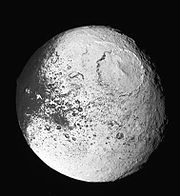
Roncevaux Terra
Encyclopedia

Saturn
Saturn is the sixth planet from the Sun and the second largest planet in the Solar System, after Jupiter. Saturn is named after the Roman god Saturn, equated to the Greek Cronus , the Babylonian Ninurta and the Hindu Shani. Saturn's astronomical symbol represents the Roman god's sickle.Saturn,...
's moon Iapetus
Iapetus (moon)
Iapetus ), occasionally Japetus , is the third-largest moon of Saturn, and eleventh in the Solar System. It was discovered by Giovanni Domenico Cassini in 1671...
. The other half of Iapetus, named Cassini Regio
Cassini Regio
Cassini Regio is the enigmatic dark area that covers half of Saturn's moon Iapetus. It is named after Giovanni Cassini, the discoverer of Iapetus; 'Regio' is a term used in planetary geology for a large area that is strongly differentiated in colour or albedo from its surroundings...
, is extremely dark. It is believed that Roncevaux Terra is the underlying colour of Iapetus, while Cassini Regio was formed either by a substance that has covered up the brighter ice of the rest of the moon, or by a residue left from the sublimation of Roncevaux-type water ice. For more details, see the main article on Iapetus
Iapetus (moon)
Iapetus ), occasionally Japetus , is the third-largest moon of Saturn, and eleventh in the Solar System. It was discovered by Giovanni Domenico Cassini in 1671...
.
Roncevaux Terra is named after the Battle of Roncevaux Pass
Battle of Roncevaux Pass
The Battle of Roncevaux Pass was a battle in 778 in which Roland, prefect of the Breton March and commander of the rear guard of Charlemagne's army, was defeated by the Basques...
, subject of the French
French literature
French literature is, generally speaking, literature written in the French language, particularly by citizens of France; it may also refer to literature written by people living in France who speak traditional languages of France other than French. Literature written in French language, by citizens...
poem the Chanson de Roland, after whose characters the surface features of Iapetus are named. "Terra" is a term used in planetary geology
Planetary geology
Planetary geology, alternatively known as astrogeology or exogeology, is a planetary science discipline concerned with the geology of the celestial bodies such as the planets and their moons, asteroids, comets, and meteorites...
to refer to extensive landmasses.
The largest named crater in the terra is the 504-km-diameter Engelier. It partially obscures the slightly smaller crater Gerin. Both craters are named for paladin
Paladin
The paladins, sometimes known as the Twelve Peers, were the foremost warriors of Charlemagne's court, according to the literary cycle known as the Matter of France. They first appear in the early chansons de geste such as The Song of Roland, where they represent Christian martial valor against the...
s mentioned in the Chanson de Roland.

